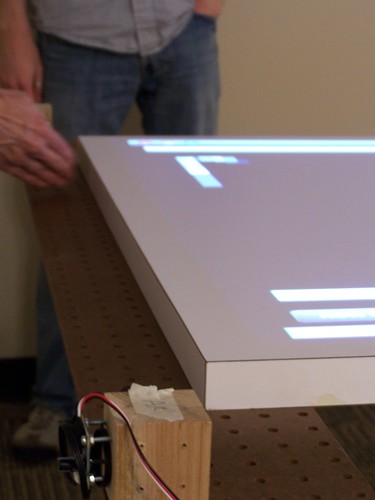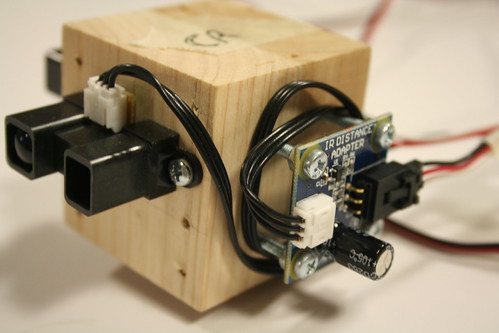Ping Platform
Ping (Physically INteractive Gaming) is a hardware and software gaming platform intended to explore new forms of physical gestures along a tabletop surface.
1 Demo of a Ping Pong game using only hand gestures.
Concept
As a first attempt into exploring physical computing, colleague Tony Dewan and I imagined an interactive gaming tabletop surface, with both hardware and software open-sourced. The finished table would be ideally installed on the IUPUI campus, freely available to the student populous. With the School of Informatics students in mind, Ping's software layer would be built upon the familiar Adobe Flex API, allowing student developers to freely publish games to the public platform and providing them a unique opportunity to design for gestural interfaces.
Gestural input

2 Horizontal hand placement acts as the primary input method.

3 A sensor block with two mounted IR distance sensors.
Not wanting to merely recreate a multitouch surface, we explored a finer subset of such gestures and sought to understand if constraining the user to a single axis would be a viable alternative to 2-dimensional input in limited use-cases. Given a single axis and (optionally) two hands, we envisioned how the user would input key commands, select objects and navigate menu items.
Each of the table's four sides provides independent controls to the system, allowing up to four simultaneous users. All gestures is derivative of user hand placement relative to the edge of the table.2 By gesturing with two hands, the user introduces a length variable (i.e. the distance between the hands) as an additional input, providing an opportunity for relatively complex gestural interactions.
To acquire such distance input, the most economical and reliable method is placing infrared distance sensors along the corners of the table, facing inward toward the middle of their respective sides. Each side, monitored by sensors on its two corners, interprets two hands (or objects) placed along the side as an input.3 By relying on Phidgets as a middle-layer between the sensors and Flex, Ping receives and adapts the data, converting it to actionable ActionScript 3 events to be interpreted by any software layer.
Ping Pong game
As a first attempt at designing a Ping multiplayer game, we created a clone of Atari's classic Pong game.1 The users' hand motion directly correlates to the placement of their respective paddles.
However, after much testing and software data correction, the gaming experience, though playable, was simply not transparent enough to continue this idea further within budgetary constraints. Provided the IR line-of-sight is essentially tunnel-vision, the user would need to be extraordinarily consistent with strict hand movements to ensure long-term reliable input.